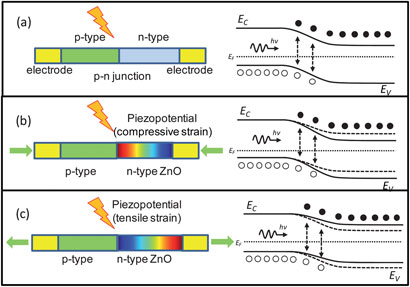US researchers have come up with an explanation for their recent results that show that introducing piezoelectric semiconductor nanowires into solar cells improves their efficiency.
Piezoelectricity is the charge created when certain materials are placed under stress, where compressing or stretching the substance generates electricity. Piezoelectric materials have been used as sensors in cars, as energy scavengers and also as ignition sources in electric lighters. Researchers across the world are working on improving the efficiency of photovoltaic devices, but until recently hadn’t thought of harnessing piezo-potential to do so.

Schematic and energy band diagram of (a) a general nanowire piezoelectric solar cell fabricated using a p-n junction structure. Schematics and energy band diagram of the piezoelectric solar cells under (b) compressive strain and (c) tensile strain, where the polarity and magnitude of the piezopotential can effectively control the carrier generation, separation and transport characteristics. The colour code represents the distribution of the piezopotential at the n-type semiconductor
Interested to know more? Read the full article in Chemistry World here…
Read the Communication from EES:
Piezo-phototronics effect on nano/microwire solar cells
Yan Zhang , Ya Yang and Zhong Lin Wang
Energy Environ. Sci., 2012, Advance Article
DOI: 10.1039/C2EE00057A










